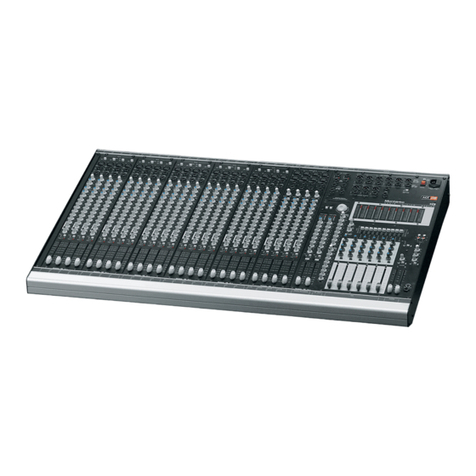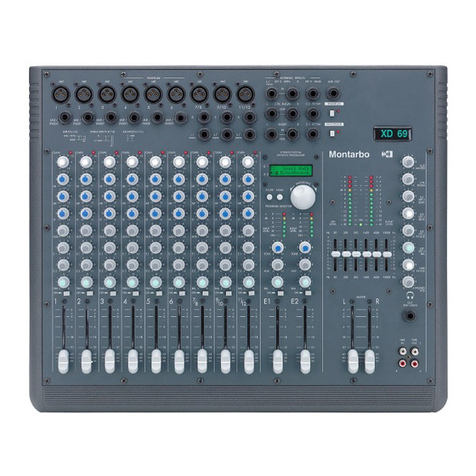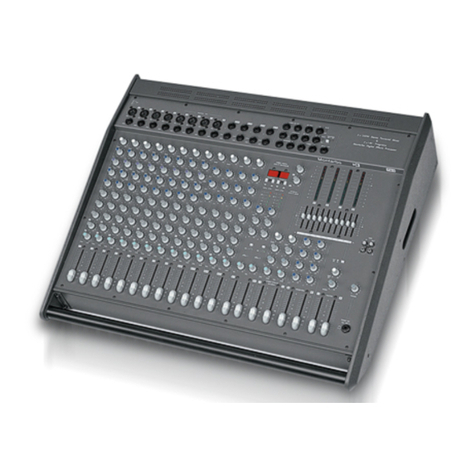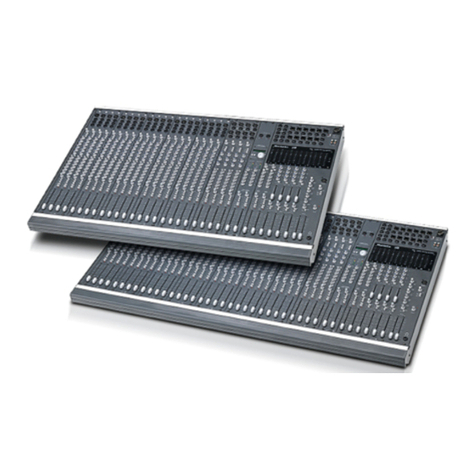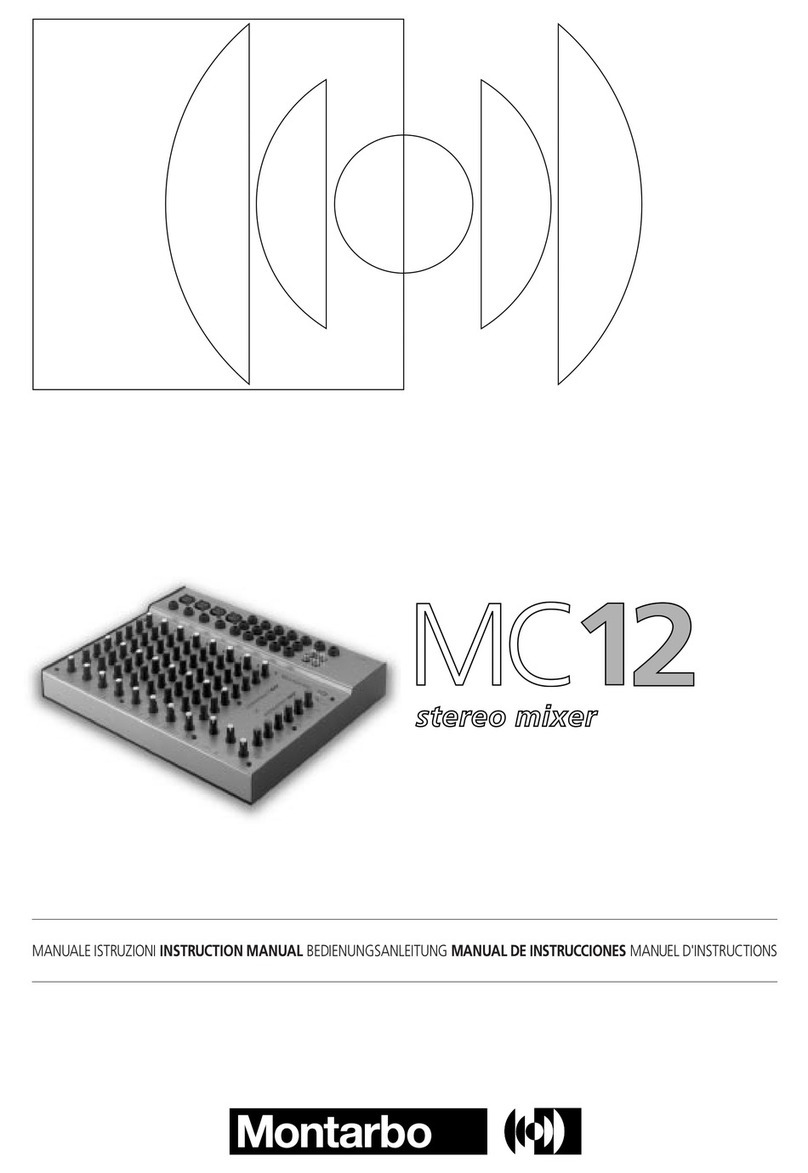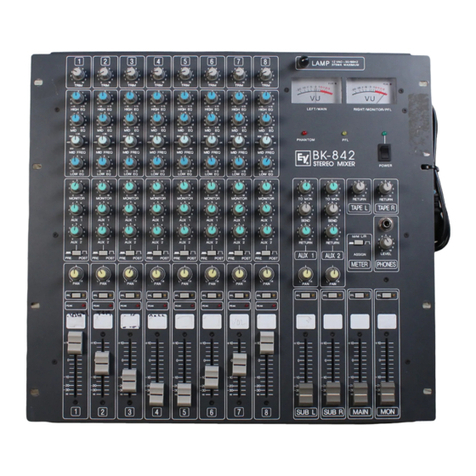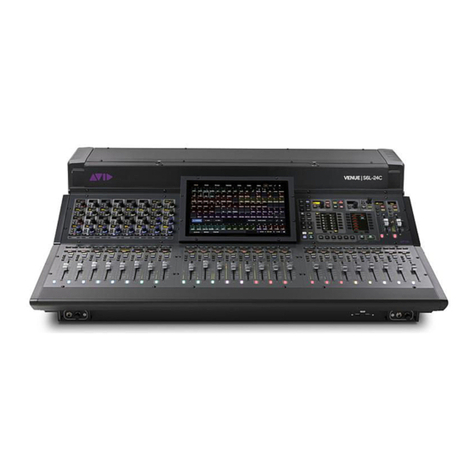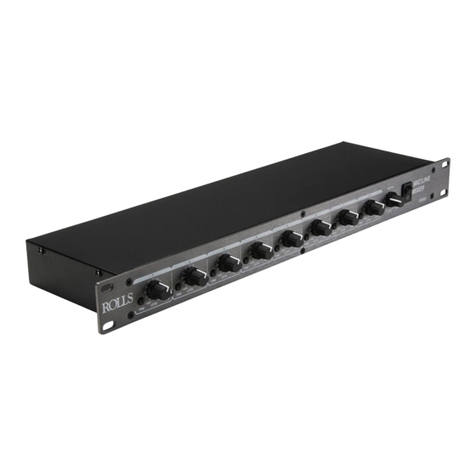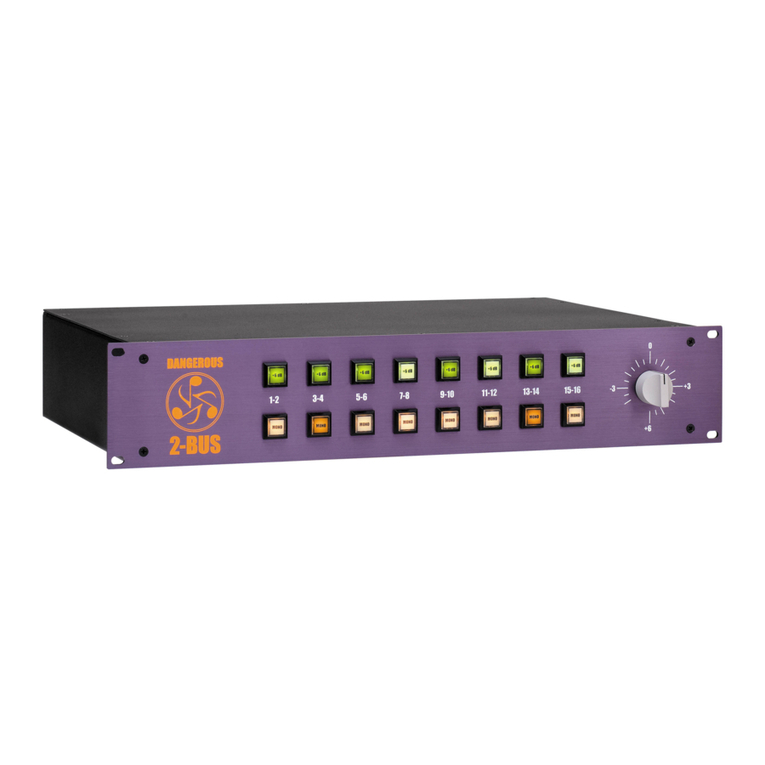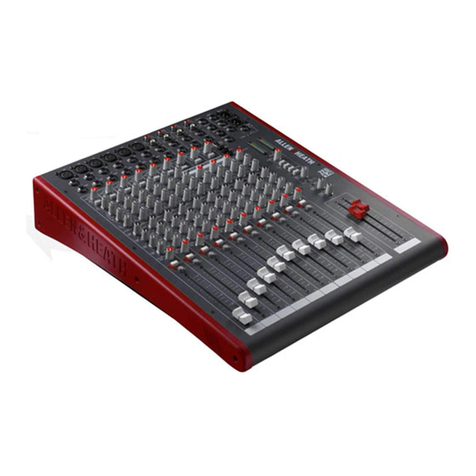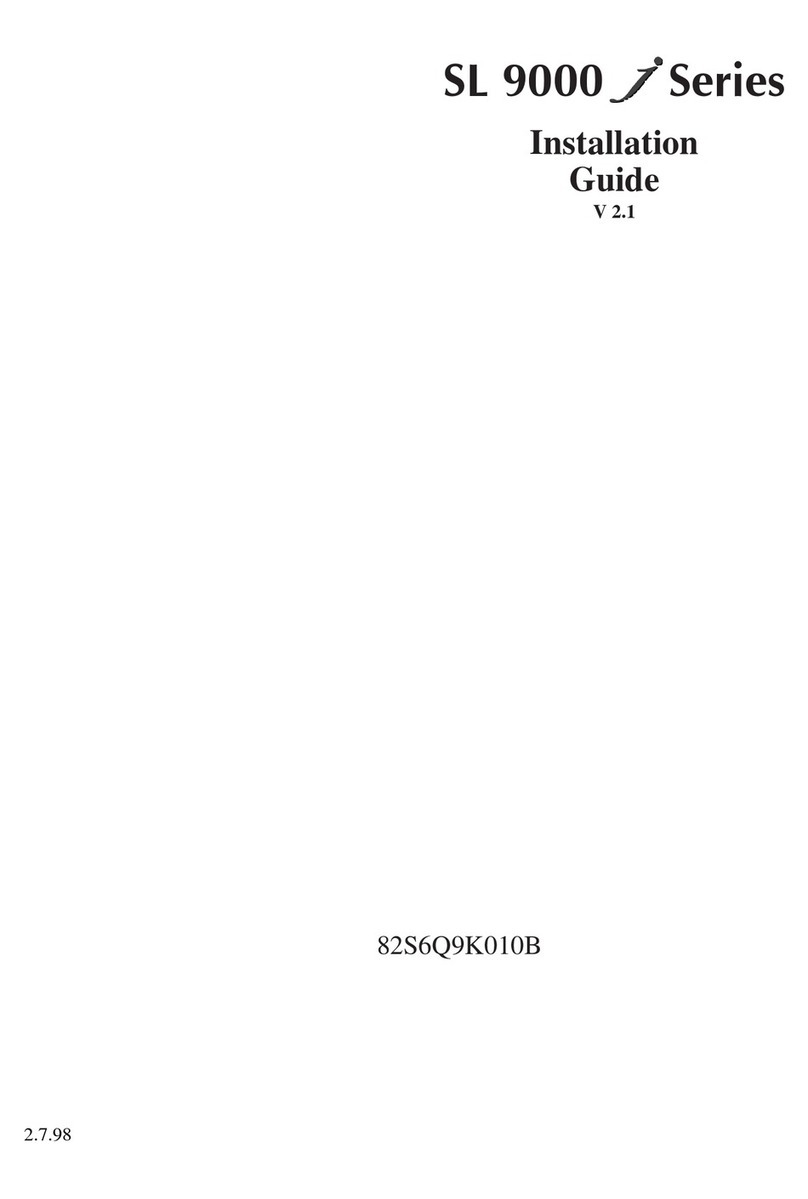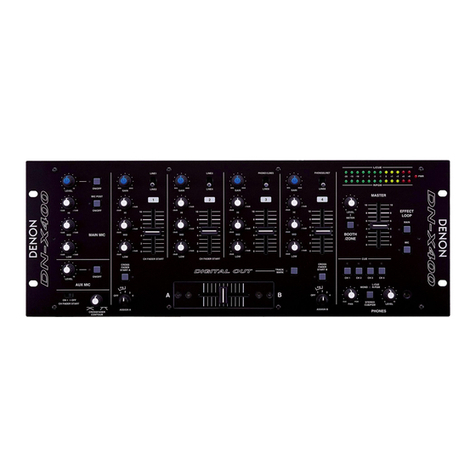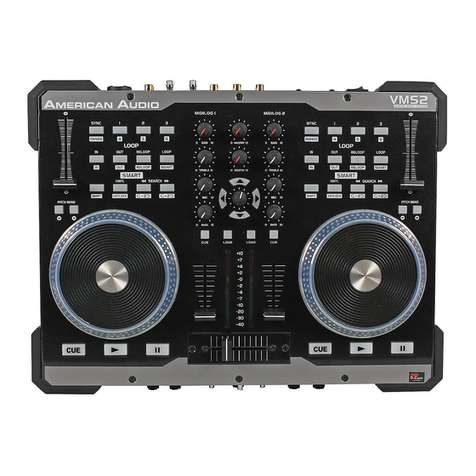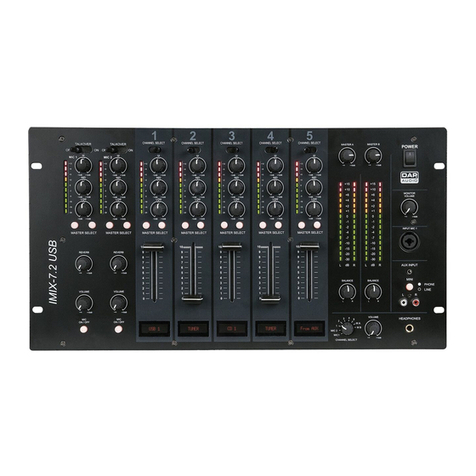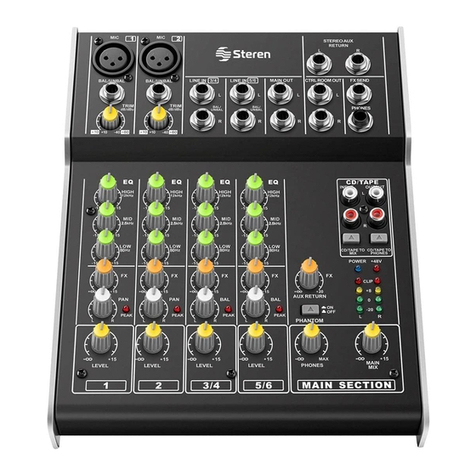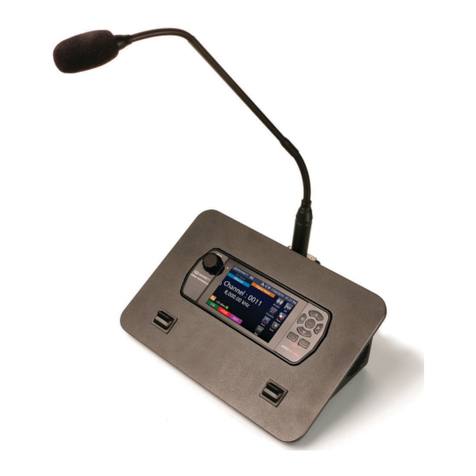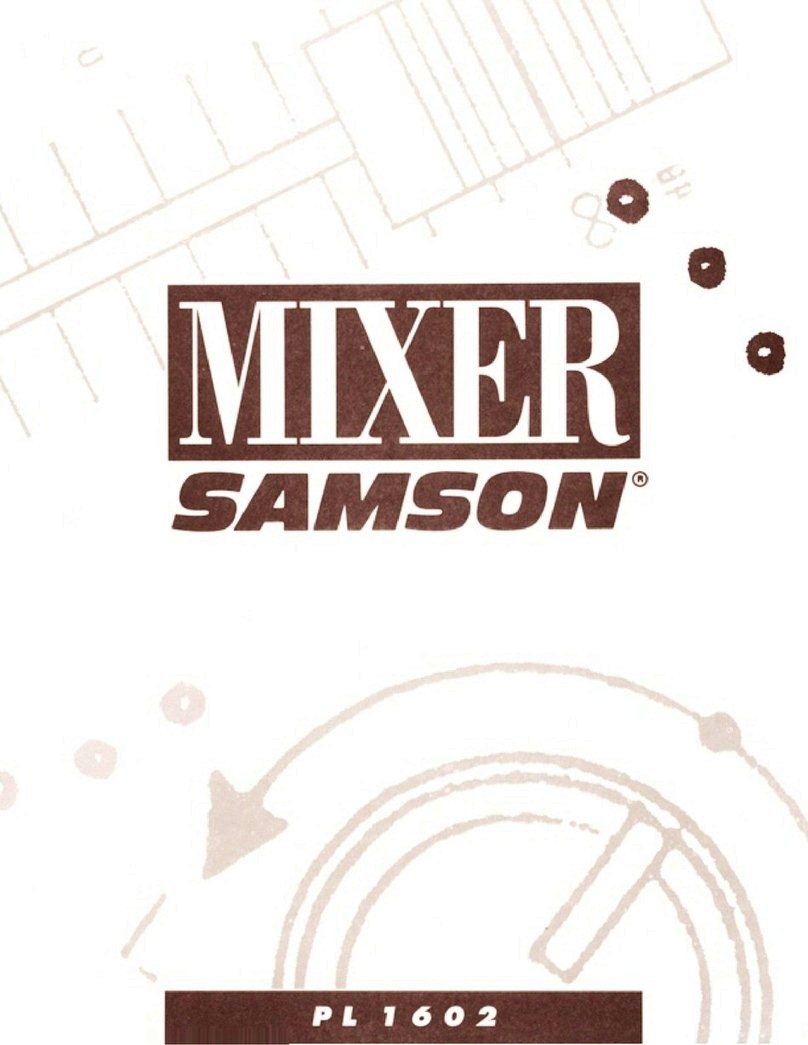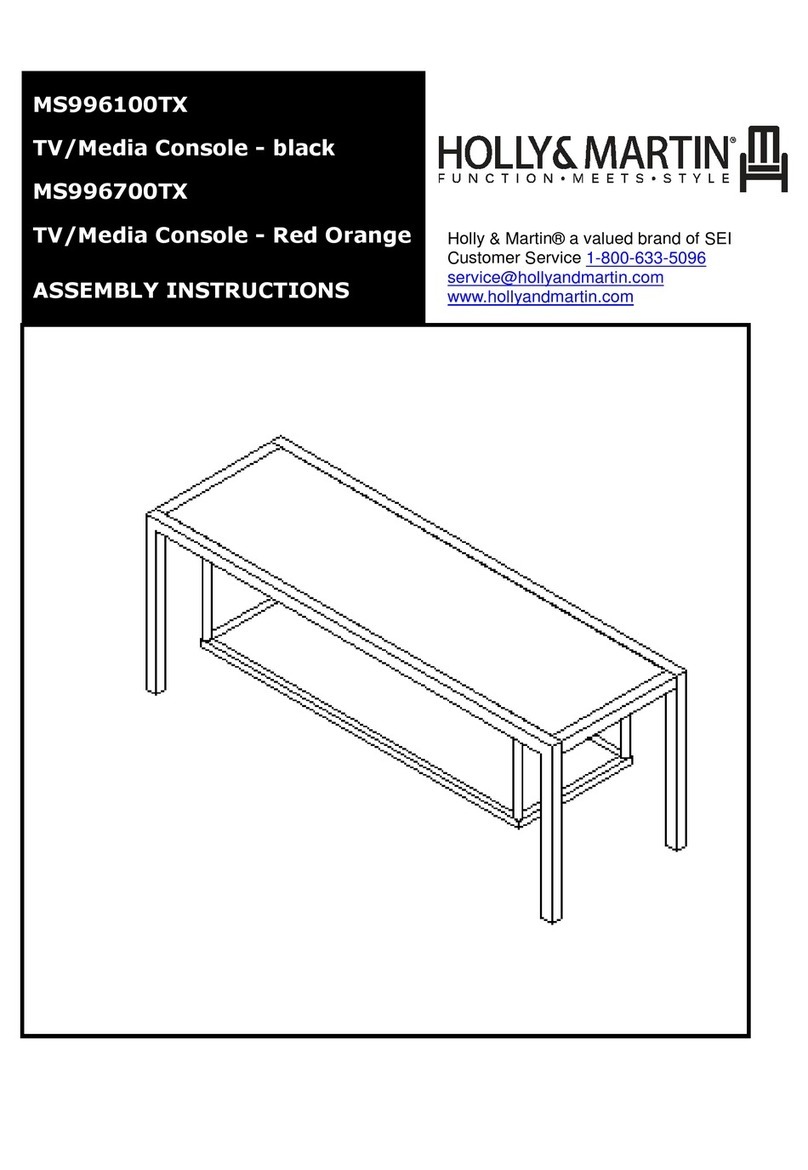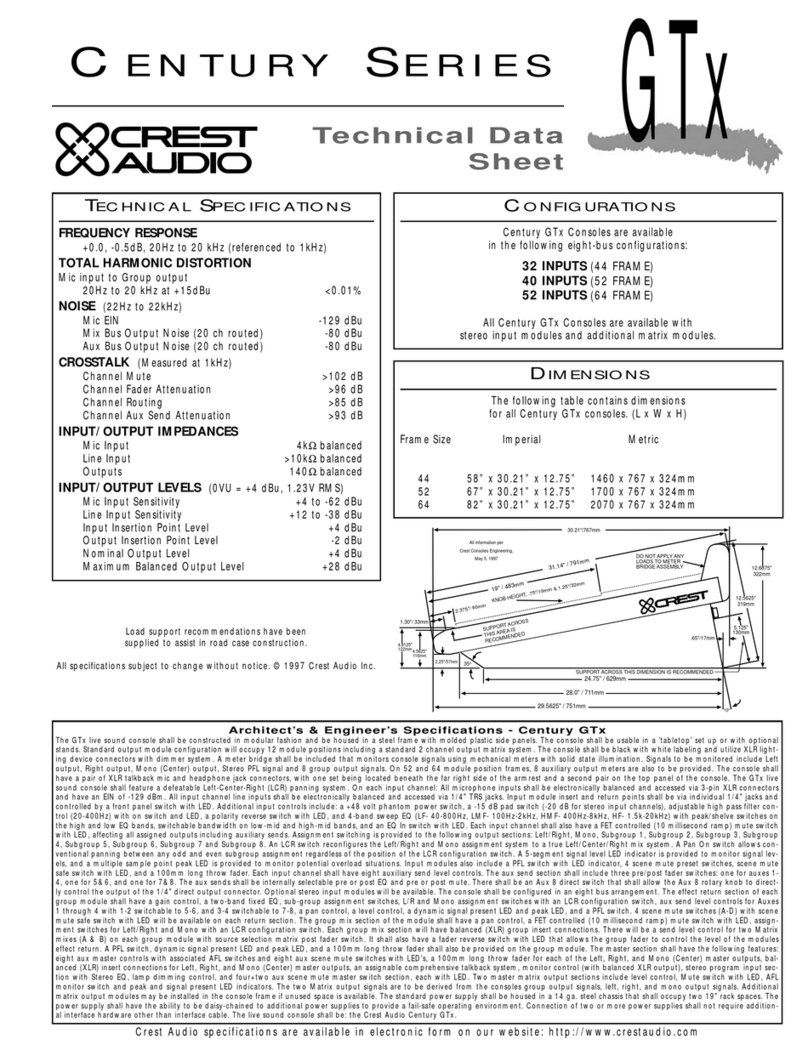Montarbo XD13 User manual


Montarbo
XD13 - AD 52 FRONT PANEL
2
AD 52 REAR PANEL
XD13 REAR PANEL
MIC
LINE /
INSERT
MIC MIC
R
MIC
R
49/107/85/6
321
40
30
18
6
0
6
50
40
30
18
6
0
6
50
40
30
18
6
0
6
50
40
30
18
6
0
6
50
AUX
MF
LF
GAIN
10
64
28
CL
HF
15
22
8
15
8
EFF
10
64
2
0
8
10
64
2
0
8
15
22
8
15
8
8
15
22
15
8
AUX
MF
LF
GAIN
10
64
28
CL
HF
15
22
8
15
8
EFF
10
64
2
0
8
10
64
2
0
8
15
22
8
15
8
15
22
8
15
8
PAN
M
AUX
MF
LF
GAIN
10
64
28
CL
HF
15
22
8
15
8
EFF
RL
10
64
2
0
8
10
64
2
0
8
15
22
8
15
8
15
22
8
15
8
PAN
M
AUX
MF
LF
GAIN
10
64
28
CL
HF
15
22
8
15
8
EFF
RL
10
64
2
0
8
10
64
2
0
8
15
22
8
15
8
15
22
8
15
8
45679810321
BAL
RL
BAL
RL
TAPE
IN VOL
PHONES VOL
MASTER
IN OUT
RR
TAPE TAPE
LL
INSERT
AUX OUT
EFF SEND EFF RETN
LR
R
IN
L /
mono
Montarbo
FT. SW.
EFF
TO AUX
EFF
BAL
EFF
RETN
AUX
MASTER
EFF
SEND
1 - GND
2 - +
3 -
XLR
200 600
OUT
PROGRAM
10
64
2
0
8
9
6
3
0
3
6
9
12
15
18
21
24
LEFT
LEVEL
RIGHT
LEVEL
9
6
3
0
3
6
9
12
15
18
21
24
+
+
+
+
+
+
dB dB
ON
0
+
10
64
2
0
8
10
64
2
0
8
10
64
2
0
8
10
64
2
0
8
10
64
2
0
8
10
64
2
0
8
RL
CL
ON
10
64
2
0
8
RL
BAL
PROCESSOR
40
30
18
6
0
6
50
40
30
18
6
0
6
50
40
30
18
6
0
6
50
PARAMETER
AUX
TONE
DIGITAL PROCESSOR
11 12 L R
EFF
11/12
LINE /
INSERT
SEND
LINE/
RETN
L /
mono
L /
mono
L /
mono
R
8
9
1
2
3
4
5
6
10
11
12
13
14
15
16
17
19
21
22
23
24
25
26
27
20
28 44
33
34
37
38
29
30
31
32
39
40
47
46
35
36
7
18
45
I
0
MOD.
MADE IN ITALY BY
ELETTRONICA
Montarbo
S.R.L.
XD 13
SERIAL N.
OUTPUTS
R
POWER RIGHT LEFT
L
1 - GND
2 - signal
3 - GND
220V-240V
50-60Hz
FUSE T 0,5A
Montarbo
41 48 49 42
MOD.
MADE IN ITALY
AD 52
STEREO POWERED MIXER
SERIAL N.
Montarbo
CET APPAREIL DOIT ETRE RELIE A LA TERRE
POUR PREVENIR TOUT RISQUE DE FEU REPLACER
TOUJOURS UN FUSIBLE DE MEME CARACTERISTIQUES
AVIS !
POUR PREVENIR TOUT RISQUE DE CHOC
ELECTRIQUE, NE PAS OUVRIR
`
^
^
TO PREVENT RISK OF FIRE ALWAYS REPLACE
FUSES WITH SAME TYPE AND RATINGS
THIS APPARATUS MUST BE EARTHED
CAUTION !
TO PREVENT ELECTRICAL SHOCK,
DO NOT REMOVE COVERS
220V-240V
50-60Hz 1 - gnd
2 - signal
3 - n.c.
POWER
I
0
SPEAKER OUTPUTS
180W 180W
FUSE T 3,15A
FUSE
F 5A FUSE
F 5A
MIN LOAD 4
RIGHT LEFT
MIN LOAD 4
F
U
S
E
F
U
S
E
41 43
43
48 49

Montarbo
__________________________________________
__________________________________________
__________________________________________
__________________________________________
__________________________________________
__________________________________________
__________________________________________
__________________________________________
__________________________________________
__________________________________________
__________________________________________
INDICE
Pannello frontale e posteriore
Controlli e connessioni
Importante !
Processore digitale di effetti stereo
Appendix:
◗XD13
-
AD
52 Dati tecnici
◗XD13 Schema a blocchi
◗AD
52 Schema a blocchi
◗XD13
-
AD
52 Connessioni
◗ XD13
Esempi di collegamento
◗ AD52
Esempi di collegamento
3
ITALIANO
2
4 - 5
6
7
13 - 22
14
15
16
17 - 20
21
22
Il lampo con la freccia inserito in un triangolo equilatero avvisa l'utilizzatore circa la
presenza di 'tensione pericolosa', senza isolamento, all'interno dell'apparecchio che
potrebbe essere sufficientemente alta da generare il rischio di scossa elettrica.
Il punto esclamativo inserito in un triangolo equilatero avvisa l'utilizzatore circa la
presenza di importanti istruzioni per l'utilizzo e per la manutenzione nella documen-
tazione che accompagna il prodotto.
IMPORTANTE ! Norme di sicurezza
ATTENZIONE !
Nell'interesse della propria e della altrui sicurezza, e per non
invalidare la garanzia, si raccomanda una attenta lettura di
questa sezione prima di adoperare il prodotto.
-Questo apparecchio è stato progettato e costruito per venire utilizzato
come mixer/mixer amplificato nel contesto tipico di un sistema di amplifi-
cazione sonora, e/o di un sistema di registrazione sonora.
L'utilizzo per scopi diversi da questi non è contemplato dal costruttore, ed
avviene pertanto sotto la diretta responsabilità dell'utilizzatore/installatore.
Per evitare il rischio di incendio e/o di folgorazione:
•Non esporre il prodotto alla pioggia non utilizzarlo in presenza di elevata
umidità o vicino all'acqua. Non lasciare penetrare all'interno dell'apparec-
chio alcun liquido, né alcun oggetto solido. In caso ciò avvenga, scollegare
immediatamente l'apparecchio dalla rete elettrica e rivolgersi ad un servi-
zio di assistenza qualificato prima di adoperarlo nuovamente.
•Prima di collegare l'apparecchio alla rete elettrica assicurarsi che la ten-
sione corrisponda a quella indicata sull'apparecchio stesso.
•Collegare questo apparecchio esclusivamente ad una presa di corrente
dotata di contatto di terra rispondente alle norme di sicurezza vigenti tra-
mite il cavo di alimentazione in dotazione. Nel caso in cui il cavo necessiti
di sostituzione, utilizzare esclusivamente un cavo di identiche caratteristiche.
•Non appoggiare alcun oggetto sul cavo di alimentazione. Non posarlo
dove possa costituire intralcio e causare inciampo. Non schiacciarlo e non
calpestarlo.
•Durante il funzionamento non coprite il mixer e non tenetelo dentro a
contenitori che possano ostruire la circolazione d'aria (necessaria al raf-
freddamento). Non ostruire le aperture o le prese d'aria presenti sull'ap-
parecchio (AD52).
•In caso di sostituzione del fusibile esterno, utilizzare esclusivamente
un fusibile di caratteristiche identiche, come riportato sull'apparecchio.
•Prima di effettuare qualsiasi operazione di collegamento, assicurarsi
che l'interruttore di accensione dell'apparecchio sia in posizione 'Off'.
•Prima di effettuare qualsiasi spostamento del prodotto già installato
o in funzione, rimuovere tutti i cavi di collegamento.
•Per scollegare l'apparecchio dalla rete elettrica, non tirare mai lungo
il cavo, ma afferrarlo sempre per il connettore.
-Nel predisporre l'apparecchio all'utilizzo, assicurarsi che la forma e la por-
tata della superficie di appoggio siano idonee a sostenerlo.
-
Per evitare urti riservate come luogo per l'istallazione del prodotto un'area
protetta inaccessibile a personale non qualificato. Qualora l'apparecchio
venga utilizzato in presenza di bambini e animali, si rende necessaria una
strettissima sorveglianza.
-Questo prodotto utilizzato insieme a cuffie o a casse acustiche è in grado
di generare pressioni acustiche molto elevate, pericolose per la salute del
sistema uditivo. Evitarne quindi l'utilizzo ad elevati o fastidiosi livelli acustici.
Non esporre i bambini a forti sorgenti sonore.
ATTENZIONE !
Questo apparecchio non contiene parti interne destinate all'inter-
vento diretto da parte dell'utilizzatore. Per evitare il rischio di
incendio e/o folgorazione, non aprirlo. Per qualsiasi intervento
di manutenzione o riparazione, rivolgersi alla Elettronica
Montarbo srl e/o a personale altamente qualificato specificamen-
te segnalato da questa.

Montarbo
4
CONTROLLI E CONNESSIONI
CANALE D'INGRESSO MONO
1 ➤GAIN: controlla il guadagno dello stadio di ingresso, permetten-
do il collegamento di sorgenti sia microfoniche che di linea aventi
segnali di uscita estremamente variabili. Come regola generale, al
fine di contenere al minimo il rumore, consigliamo di regolare il
GAIN al massimo livello possibile, evitando però che l'indicatore di
picco (CL) si illumini.
2 ➤H.F / M.F / L.F. Equalizzazione a 3 bande.
H.F: controlla il livello delle frequenze alte. La frequenza di interven-
to è 15kHz, l'accentuazione/attenuazione 15dB.
M.F: controlla il livello delle frequenze medie. La frequenza di inter-
vento è 600Hz, l'accentuazione/attenuazione 15dB.
L.F: controlla il livello delle frequenze basse. La frequenza di interven-
to è 50Hz, l'accentuazione/attenuazione 15dB.
N.B: Girando la manopola in senso orario si ottiene una accentuazione, in senso
antiorario una attenuazione. In posizione centrale la risposta è lineare.
3 ➤AUX: volume mandata ausiliaria. Permette di regolare la
quantità di segnale del canale nell'uscita ausiliaria (dipende dai
controlli di tono ed è indipendente dal volume del canale).
4 ➤EFF: volume mandata effetto (dipende dai controlli di tono e
volume del canale). Permette di regolare la quantità di segnale del
canale da inviare sia all'effetto interno che all'eventuale effetto
esterno collegato alle prese send e return.
N.B: Sui canali dove non si vuole avere l'effetto interno e neppure l'eventuale
effetto esterno, girare questa manopola in senso completamente antiorario.
Se si vuole avere solamente l'effetto esterno, disattivare l'effetto interno.
5 ➤PAN: controllo di panorama. Permette di posizionare il segnale
(del canale) nell’immagine stereo inviandolo in quantità maggiore o
minore alle uscite master L ed R.
6 ➤VOLUME del canale.
7 ➤CL: indicatore LED di picco (clipping). Si illumina quando il livel-
lo del segnale è prossimo alla distorsione. Il segnale è controllato
contemporaneamente in due punti del canale: • dopo l'amplificato-
re di ingresso (micro e linea); • dopo l'equalizzatore.
Se il led CL si accende con continuità, è necessario ridurre il guada-
gno di ingresso (GAIN) o regolare diversamente l'equalizzazione del
canale riducendo l'esaltazione introdotta dai comandi HF, MF, LF.
●connessioni:
8 ➤MIC: ingresso microfonico bilanciato con connettore XLR
(per il collegamento di microfoni).
9 ➤LINE: ingresso linea sbilanciato con connettore jack per il
collegamento di strumenti e sorgenti di segnale ad alto livello.
Incorpora anche la connessione Insert, utilissima per trattare canali
diversi, con apparecchi esterni, singolarmente.
N.B: Non usare contemporaneamente i due ingressi MIC e LINE.
Non collegare strumenti (o altre sorgenti ad alto livello) all'ingresso MIC !
(questo comporterebbe distorsione dovuta al segnale eccessivo).
Non collegare microfoni all'ingresso LINE ! (il segnale sarà di basso livello e
qualità).
CANALE D'INGRESSO STEREO
10 ➤GAIN: come nel canale mono.
11 ➤H.F / M.F / L.F: come nel canale mono.
12 ➤AUX: come nel canale mono.
.
13 ➤EFF: come nel canale mono.
14 ➤BAL: controllo bilanciamento. Permette di regolare il livello
relativo destro/sinistro del segnale stereo del canale nelle uscite
master L/R. Se il canale viene usato in mono diventa un comando
PAN (panorama).
15 ➤VOLUME del canale.
16 ➤CL: come nel canale mono.
●connessioni:
17 ➤MIC: per dare ai mixer una maggiore flessibilità di impiego,
anche i canali stereo dispongono di un ingresso microfonico
bilanciato (XLR) mono.
18 ➤L/R: ingressi linea sbilanciati jack per il collegamento di
strumenti stereo. Per collegamenti 'mono' utilizzare l'ingresso
'L / mono'.
PROCESSORE DIGITALE DI EFFETTI STEREO
Il processore è basato su un DSP a 56 bit con conversione Delta/
Sigma a18bit. Offre 16 diversi effetti modificabili in tempo reale di
grande qualità, prestazioni altamente professionali ed una estrema
facilità di utilizzo.
19 ➤DISPLAY numerico a LED: indica il numero corrispondente al
programma selezionato.
20 ➤PROGRAM: 2 pulsanti di selezione dei programmi permettono
di selezionare qualsiasi numero della memoria per richiamare uno
dei 16 programmi disponibili.
▼= tasto di decremento
▲= tasto di incremento
21 ➤ON: pulsante per attivare o disattivare l’effetto, con indicatore
LED rosso.
22 ➤PARAMETER: controllo che consente di modificare i parametri
dell'effetto scelto mediante i pulsanti di selezione dei programmi.
23 ➤AUX: mandata ausiliaria. Permette di regolare il livello dell’ef-
fetto stereo sull'uscita miscelata aux.
24 ➤TONE: controllo di tono. Girando la manopola in senso orario
si produce una graduale attenuazione delle alte frequenze (in senso
completamente antiorario la risposta è lineare).
25 ➤BAL: bilanciamento. Permette di regolare il livello relativo
destro/sinistro del segnale stereo dell’effetto da inviare alle uscite
master L ed R.
26 ➤Controllo di VOLUME.
27 ➤CL: indicatore LED di picco (clipping). Se lampeggia occasional-
mente la condizione di funzionamento è normale, mentre se resta
continuamente acceso è molto vicina alla saturazione ed è necessa-
rio diminuire il volume delle mandate effetto sui singoli canali.
●connessioni:
28 ➤FT/SW: presa jack per footswitch. Consente di disattivare
l'effetto mediante pedale. Ciò è possibile solo quando il relativo
pulsante 'ON' è premuto.

Montarbo
N.B: Se si utilizzano dei connettori jack mono, le prese insert L/R possono fungere
da uscite master L/R. In tal caso le uscite XLR saranno scollegate.
☛
Figura 1A pag. 17
43➤AD52 SPEAKER OUTPUTS L/R: uscite dei due amplificatori in-
corporati. L'impedenza minima per ogni amplificatore è di 4Ω.
■Collegare 1 o 2 casse acustiche da 8 Ωper ogni uscita. Mai fare
funzionare gli amplificatori interni con carichi inferiori a 4Ωciascuno.
N.B: Ogni uscita dispone di prese Jack e XLR (in parallelo), fusibili di protezione,
protezioni elettroniche, relè per inserimento ritardato del carico, autodiagnosi,
ventilazione forzata.
☛
Figura 1B pag. 18
44 ➤INSERT L/R: prese jack stereo che permettono il collegamento
di apparecchiature ausiliarie esterne (ad esempio equalizzatori gra-
fici, limiter processore audio, ecc…) alle uscite master L/R.
Dipendono dalle regolazioni master L ed R. Per l'inserzione di appa-
recchiature esterne vedere esempio di collegamento.
☛
Figura 2A pag. 19
Nel mixer XD13 queste prese possono anche essere utilizzate
come normali uscite L/R usando jack mono standard. In questo caso
le uscite XLR sono disattivate.
☛
Figura 2A pag. 19
Nel mixer amplificato AD52 queste prese possono anche essere
utilizzate come uscite preamplificate del mixer per collegare casse
amplificate o amplificatori esterni.
■Per utilizzare le uscite linea del mixer senza escludere le uscite di
potenza prelevare il segnale dalle due prese insert mediante due jack
stereo, neiquali avrete precedentemente collegato l'anella (RING) con
la punta (TIP) cortocircuitandole,ed inviarlo agli ingressi delle casse
autoamplificate mediante dei jack mono.
☛
Figura 2B pag. 19
• Collegando alle prese insert dei jack mono le uscite degli amplificatori vengono
invece escluse.
45 ➤AUX OUT: uscita ausiliaria (monitor). Può pilotare fino a 10
casse monitor autoamplificate, collegate in parallelo.
■Collegare l'uscita AUX all'ingresso del monitor amplificato.
Regolare le mandate AUX di ogni canale ed il volume AUX MASTER.
☛
Figura 3pag. 19
N.B: Se non viene utilizzata per i monitor, può servire come mandata effetto
(vedi fig. 4).
46 ➤TAPE IN/OUT L/R: ingressi e uscite (prese PIN-Rca) per il colle-
gamento di un registratore stereo.
■Collegare le prese TAPE OUT L/R del mixer agli ingressi (line in) del
registratore e le uscite (line out) del registratore alle prese TAPE IN
L/R del mixer. Se gli ingressi TAPE IN non vengono utilizzati, si consi-
glia di tenere al minimo il volume TAPE IN VOL.
■ Per riprodurre nastri già registrati porre il registratore in riproduzio-
ne e regolare opportunamente il volume "TAPE IN VOL" del mixer
(ed i volumi di uscita del registratore, se presenti).
■ Per registrare dall'impianto: porre il registratore in registrazione e
regolare opportunamente i volumi di ingresso del registratore.
Porre al minimo il volume di uscita del registratore. Nel caso in cui
il vostro registratore non disponga di questo controllo, scollegare i
cavetti dalle prese TAPE IN. Il segnale inviato al registratore non
dipende dalla regolazione dei volumi master L/R.
N.B: Gli ingressi TAPE IN L ed R sono normali ingressi di linea ed è perciò possibile
utilizzarli per collegare qualsiasi segnale di linea (ad esempio le uscite di un mixer,
strumenti, expander...).
☛
Figura 5pag. 20
47 ➤PHONES OUT: presa jack per cuffia stereo.
48 ➤Presa di rete a vaschetta con fusibile incorporato, per il colle-
gamento del cavo di alimentazione fornito di corredo.
49 ➤Presa di terra supplementare.
MANDATE E RITORNI EFFETTI ESTERNI
29 ➤EFF SEND: controllo di volume per la mandata effetti. Regola il
livello di segnale presente sull'uscita EFF SEND ed è la miscelazione
dei segnali inviati dalle mandate EFF dei singoli canali.
30 ➤EFF RETN: controllo di volume per il ritorno effetti. Regola il
livello di segnale del ritorno effetto esterno.
31 ➤EFF TO AUX: regola la quantità di effetto esterno da inviare
all'uscita AUX (monitor).
32 ➤EFF BAL: bilanciamento stereo dell’effetto esterno. Permette
di regolare il livello relativo destro/sinistro del segnale stereo dell’ef-
fetto da inviare alle uscite master L ed R.
●connessioni:
33 ➤EFF SEND: uscita jack per la mandata effetto esterno.
34 ➤EFF RETN L/R: 2 ingressi jack per il ritorno stereo dell'effetto.
• Sono utilizzabili anche come 2 ingressi linea extra.
■Collegare la presa EFF SEND all'ingresso dell'effetto esterno.
■Collegare le uscite L ed R dell'effetto esterno alle prese EFF RETN
L/R del ritorno effetti stereo.
• Per un effetto mono collegare l'uscita
'only effect'dell'effetto alla presa'L/mono'
■Utilizzare i controlli EFF di ogni canale per regolare la quantità di
segnale da inviare all'effetto esterno, il controllo EFF SEND (29) per
regolare la quantità di segnale da inviare all'uscita "eff send", ed i
controlli EFF RETN, EFF TO AUX e EFF BAL (30, 31, 32) per regolare
il ritorno dell'effetto e le quantità dello stesso da inviare all'uscita
"aux" ed ai master "L/R".
• Alla mandata EFF su ogni canale corrisponde anche l'effetto interno.
Per escludere quest'ultimo, disattivarlo mediante il comando 'on'.
N.B: Anzichè dell'uscita EFF
SEND, ci si può servire dell'uscita AUX (se non è impe-
gnata per i monitor). In tal caso il segnale dell'effetto esterno sarebbe regolabile
mediante la mandata AUX di ogni canale e quindi totalmente indipendente.
☛
Figura 4pag. 20
SEZIONE MASTER
35 ➤L/R MASTER: livelli generali per le uscite master L (sinistra)
ed R (destra).
36 ➤LEFT/RIGHT LEVEL: 2 rampe di LED a 12 segmenti che indicano
il livello delle uscite master L ed R.
37 ➤PROCESSOR: premendo questo pulsante si attiva un processo-
re in grado di modificare il contenuto armonico delle uscite master
L ed R consentendo di ottenere un suono 'corposo' anche a livelli di
ascolto bassi (molto utile quindi per piano-bar e simili).
Nell'XD13, tale processore agisce solamente sulle uscite XLR (e per-
tanto gli Insert L ed R non ne vengono influenzati) mentre nell'AD52
agisce sulle uscite amplificate.
38 ➤AUX MASTER: controlla il volume dell'uscita ausiliaria (monitor).
L'uscita master ausiliaria è la miscelazione di tutte le mandate AUX
dei singoli canali.
39 ➤TAPE IN VOL: volume dell’ingresso Tape.
40 ➤PHONES VOL: volume dell’uscita in cuffia.
41 ➤POWER: interruttore generale dell'apparecchio.
●connessioni:
42 ➤XD13 LEFT/RIGHT OUTPUTS: uscite master L ed R per il colle-
gamento di finali di potenza o casse acustiche amplificate.
■Collegare le prese di uscita LEFT - RIGHT agli ingressi dei finali di
potenza o delle casse acustiche autoamplificate. Regolare i fader dei
volumi di ogni canale ed i controlli delle uscite master L ed R.
Ogni uscita può pilotare fino a 10 casse acustiche autoamplificate o
finali di potenza collegati in parallelo.
5
CONTROLLI E CONNESSIONI

Montarbo
6
IMPORTANTE!
CURA E MANUTENZIONE
☞
Posizionare il mixer lontano da fonti di calore (caloriferi o
qualsiasi altro oggetto che produca calore).
☞
Evitate di esporre il mixer alla irradiazione solare diretta,ad ecces-
sive vibrazioni e a urti violenti.
☞
Evitate l’uso e il deposito in ambienti eccessivamente polverosi
o umidi: eviterete così cattivi funzionamenti e deterioramento anti-
cipato delle prestazioni.
☞
Evitate di utilizzare il mixer vicino a forti fonti di radiazioni elet-
tromagnetiche (video dei monitor, cavi elettrici di alta potenza):
ciò può provocare una diminuzione della qualità audio.
☞
Abbiate cura dei cavi di collegamento, avvolgeteli evitando nodi
e torsioni.
☞
Proteggere l'apparecchio dal rovesciamento accidentale di liquidi
o sostanze di qualsiasi tipo. In particolare nelle condizioni di utilizzo
tipiche, prestare la massima attenzione alla collacazione dell'appa-
recchio onde evitare che il pubblico, i musicisti, i tecnici o chicches-
sia possa poggiare bicchieri, tazze, contenitori di cibo o di bevande,
portacenere e sigarette accese sull'apparecchio.
☞
Non forzate i comandi (manopole, interruttori, cursori).
☞
Per rimuovere la polvere dal pannello usate un pennello o un
soffio d’aria. Non usate mai alcool, detergenti o solventi.
☞
In caso di necessità di assistenza, rivolgetevi alla Elettronica
Montarbo srl o a personale altamente qualificato.
INSTALLAZIONE ED USO
☛
Collegamento alla rete: • utilizzare il cavo di alimentazione a tre
poli di corredo; • collegarlo sempre ad una presa di corrente dotata
di contatto di terra; • accertarsi che la tensione di rete corrisponda
a quella indicata sull’apparecchio.
☛
Utilizzare cavi di collegamento e connettori di qualità.
☛
Utilizzare cavi schermati per i collegamenti agli ingressi micro-
fonici e linea, alle prese send/return, all'uscita aux, alle prese tape
in/out ed alle prese insert L/R.
☛
Nel mixer XD13: utilizzare cavi schermati per il collegamento
di casse acustiche attive alle uscite master L/R.
☛
Nel mixer amplificato AD52: utilizzare cavi non schermati
di adeguata sezione per il collegamento di casse acustiche passive
alle uscite amplificate L/R. Non utilizzare gli amplificatori con un
carico inferiore a 4 ohm ciascuno.
☛
Prima di accendere o spegnere l’apparecchio, chiudete (met-
tendo al minimo i fader) le uscite master.
COLLEGAMENTI E REGOLAZIONI INIZIALI
❉
Collegare le casse acustiche.
❉
Collegare i microfoni agli ingressi XLR e gli strumenti agli ingressi
jack.
☛
Non collegate i microfoni agli ingressi LINE!
❉
Prima di accendere l'apparecchio, mettere tutti i volumi al minimo.
❉
Dopo avere acceso l'apparecchio, regolare i controlli di guadagno
di ogni canale al minimo, i controlli di tono e panorama in posizio-
ne centrale, le mandate ausiliarie e le mandate effetto al minimo.
☛
Per ottimizzare la dinamica di ogni canale, in base alle diverse
fonti di segnale, vi consigliamo di effettuare le seguenti operazioni:
• utilizzando il microfono (collegato alla presa XLR) nelle condizioni
di impiego a voi consuete, portare il comando GAIN in posizione
tale da fare illuminare il LED di picco, • a tal punto diminuire il gua-
dagno di quel tanto da fare spegnere il LED di picco e regolare poi il
fader del volume del canale.
☛
Il LED di picco del canale è influen-
zato esclusivamente dal controllo di guadagno e dai controlli di tono.
N.B: un canale per volta, effettuare questa operazione su tutti i canali utilizzando
le fonti di segnale per essi predisposte (voce femminile, voce maschile, strumenti)
e nelle condizioni di impiego il più possibile reali.
❉
Portare i fader dei volumi master L/R e degli effetti interni in posi-
zione vicina a '0' e il volume aux master in posizione centrale;
a questo punto alzare il volume di ogni singolo canale secondo le
proprie esigenze.

Montarbo
7
PROCESSORE DIGITALE DI EFFETTI STEREO
Programma
0
FAST ECHO
1
SLOW ECHO
2
SMALL HALO
3
LARGE HALO
4
PING PONG
5
REVERSE REVERB
6
EARLY REFLECTIONS
7
ROOM REVERB
8
HALL REVERB
9
VOICE REVERB
A
FAST ECHO + REV.
B
SLOW ECHO + REV.
C
PITCH CHANGE
D
DUAL PITCH CHANGE
E
DETUNE 1
F
DETUNE 2
Il nuovo processore digitale di effetti consente di creare infiniti effetti
diversi partendo da 16 programmi base (indicati da 0 ad F sul display
monocifra) modificabili a piacere grazie al comando 'parameter'.
All’accensione, il processore carica automaticamente il programma
numero 9(della famiglia VOICE REVERB).
La selezione dei programmi avviene semplicemente con l’utilizzo di
due pulsanti: il pulsante
▲
seleziona i programmi in ordine crescente,
mentre
▼
seleziona i programmi in ordine decrescente.
REGOLAZIONE DEGLI EFFETTI
1– Attivate l' effetto premendo il tasto ON. L’accen-
sione viene visualizzata dal LED rosso.
2– Portare il fader dell'effetto e i fader dei master
L/R in posizione 0.
3– Sui canali di ingresso ai quali desiderate aggiun-
gere l'effetto, regolate il fader di volume ed il poten-
ziometro EFF.
4– Prestate attenzione al LED rosso CL:
• può lampeggiare saltuariamente.
• l'accensione continua è invece indice di segnali
eccessivamente forti, che possono dare origine a
sgradevoli distorsioni.
Ciò non è da imputarsi ad un difetto o ad un limite
della macchina, ma è comune alla tecnologia dei
processori digitali di qualsiasi tipo.
Il LED serve appunto per avvertire che è necessario
ridurre i livelli impostati con i potenziometri EFF sui
canali.
5– Se desiderate modificare il timbro dell'effetto,
potete agire sul controllo TONE per 'scurire' o
'schiarire' la sonorità del programma selezionato.
6– Assegnate l'effetto alle uscite master L ed R con
il potenziometro BAL e/o all'uscita Aux (per avere
l'effetto sui monitor) con il potenziometro AUX e
regolate il volume dell'effetto con il fader.
7– Selezionate ora il programma desiderato con i
pulsanti
▼
e
▲
.
Utilizzate come riferimento la tabella riportata nella
colonna a fianco per imparare a conoscere le sonorità
dei diversi programmi.
Sperimentate liberamente tutti gli effetti, senza alcun timore, fino a
che non individuate i programmi che creano l’effetto più gradevole
al vostro orecchio.
• Di grande utilità è la base degli algoritmi utilizzata per i 'programmi
VOICE REV. (9) FAST ECHO + REV. (A) e SLOW ECHO + REV. (B), svilup-
pata per minimizzare l’insorgere del feedback (o effetto Larsen) nell’utilizzo
dal vivo con i monitor da palco.
•• Gli effetti EARLY REFLECTIONS (6)e ROOM REV. (7) sono particolarmen-
te adatti per segnali campionati (tastiere, batterie elettroniche, campionatori
etc..).
Descrizione effetti
Produce un delay su tempi di ritardo molto brevi. Il
comando PARAMETER aumenta il tempo di ritardo.
Simile al programma precedente, ma con base dei
tempi più ampia e quindi un effetto di maggiore 'aper-
tura'. Stessa funzione del comando PARAMETER.
Èil 'clone' digitalizzato del tipico effetto 'alone' degli
eco a rullo Montarbo degli anni '60, un classico del
vintage che non accenna a passare di moda. Il coman-
do PARAMETER dosa la lunghezza dell'effetto.
Simile al precedente, ma con una caratteristica
spaziale più aperta. Stessa funzione del comando
PARAMETER.
Il classico effetto 'autopan delay' presente sui dischi
che hanno fatto la storia del pop-rock. Le ripetizioni
dell'eco si alternano tra canale destro e canale sinistro.
Il comando PARAMETER aumenta il tempo di ritardo
e, quindi, la lunghezza della frase ripetuta.
Un classico effetto del sound anni '80 produce un
riverbero al contrario che inizia a basso volume e
aumenta man mano. Viene utilizzato soprattutto
con le percussioni. Il comando PARAMETER aumenta
il tempo di riverbero.
Aggiunge al segnale le cosiddette 'prime riflessioni'
di un riverbero ma senza includere la 'coda' dell'ef-
fetto. Arricchisce un suono rendendolo più corposo
e aggressivo senza allungarne il tempo di decadimen-
to. Si adopera di solito per rinforzare la voce, le per-
cussioni o gli assolo dei fiati. Il comando PARAMETER
allarga l'intervallo tra le prime riflessioni.
Èun riverbero molto breve, solitamente impiegato
per le percussioni. L'ambiente si 'allarga' con il co-
mando PARAMETER.
Simula il riverbero di un ambiente di grandi dimen-
sioni. Anche in questo caso il comando PARAMETER
aumenta le dimensioni dello spazio.
Specifico per dare risalto e supporto alla voce.
Il comando PARAMETER aumenta la sensazione di
spaziosità.
Combina un rapido eco ribattuto con un riverbero
per sostenere la voce. Il comando PARAMETER
aumenta la larghezza del riverbero.
Come il precedente, ma l'eco ha un tempo di ritardo
più lungo e crea quindi una ripetizione più ampia e
più 'lenta'.
Traspone l'intonazione del suono in tempo reale. Il
comando PARAMETER seleziona 4 diversi effetti di
pitch change a disposizione.
Un vero armonizzatore che permette di armonizzare
un suono monofonico (voce, strumento a fiato)
aggiungendo due parti diverse, rispettivamente sul
canale destro e sinistro.
Varia lievemente l'intonazione del suono originale
creando un effetto di 'raddoppio' molto realistico. Il
comando PARAMETER aumenta lo sfalsamento della
frequenza per controllare la quantità dell'effetto.
Come il precedente, solo con uno sfaldamento della
frequenza più consistente. Produce un effetto simile
al 'chorus', utile per le chitarre, per certi versi più
coinvolgente. Il comando PARAMETER aumenta la
variazione di frequenza.
PROGRAM
10
64
2
0
8
CL
ON
10
64
2
0
8
RL
BAL
40
30
18
6
0
6
50
PARAMETER
AUX
TONE
DIGITAL PROCESSOR
EFF

Montarbo
__________________________________________
__________________________________________
__________________________________________
__________________________________________
__________________________________________
__________________________________________
__________________________________________
__________________________________________
__________________________________________
__________________________________________
__________________________________________
CONTENTS
Front and rear panels
Control and connections
Important !
Stereo digital effects processor
Appendix:
◗XD13
-
AD
52 Technical specifications
◗
XD13 Block diagram
◗
AD
52 Block diagram
◗
XD13
-
AD
52 Connections
◗
XD13
Connection examples
◗
AD
52
Connection examples
8
2
9 - 10
11
12
13 - 22
14
15
16
17 - 20
21
22
ENGLISH
IMPORTANT ! Safety instructions
Thelightingflashwitharrowheadsymbolwithinanequilateraltriangle,isintended to
alerttheusertothepresenceofuninsulated"dangerousvoltage"withintheproduct's
enclosure,thatmaybeofsufficientmagnitude toconstituteariskofelectricshockto
humans.
Theexclamationpointwithinanequilateraltriangle,isintended to alerttheuserto
thepresenceofimportantoperatingandmaintenance(servicing)instructionsinthe
literatureaccompanyingtheproduct.
WARNING !
In order to protect your own and others' safety and to avoid
invalidation of the warranty of this product, please read this
section carefully before operating this product.
-This product has been designed and manufactured for being operated as
mixing console/powered mixing console in the applications tipical of a
sound reinforcement system
or of a sound recording system. Operation for
purposes and in applications
other than these has not been covered by the
manufacturer in the design of the product, and is therefore to be
undertaken at end user's and/or installer's sole risk and responsability.
To avoid the risk of fire and/or electric shock:
•Never expose this product to rain or moisture, never use it in proximity of
water or on a wet surface. Never let any liquid, as well as any object, enter
the product. In case, immediately disconnect it from the mains supply and
refer to servicing before operating it again.
•Before connecting this product to the mains supply, always make sure
that the voltage on the mains outlet corresponds to that stated on the
product.
•This product must be connected only to a grounded mains outlet
complying to the safety regulations in force via the supplied power cable.
In case the power cable needs to be substituted, use exclusively a cable
of the same type and characteristics.
•Never place any object on the power cable. Never lay the power cable
on a walkway where one could trip over it. Never press or pinch it.
•During operation do not cover the mixer and do not keep it in containers
which may prevent correct air circulation. Never obstruct the air intake
openings on it (AD52).
•In case the external fuse needs replacement, substitute it only with one
of the same type and rating, as stated on the product.
•Always make sure the On/Off switch is in its 'Off' position before doing
any operation on the connections of the product.
•Before attempting to move the product after it has been installed,
remove all the connections.
•To disconnect the power cable of this product from the mains supply
never pull the cable directly instead, hold the body of the plug firmly and
pull it gently from the mains supply outlet.
-Before placing the product on a surface of any kind, always make sure
that its shape and load rating will safely match the product's size and
weight.
-
To avoid shocks always reserve a protected area with no access to unqualified
personnel as installation site of the product. In case the product is used near
children and animals closest supervision is necessary.
-This product in combination with headphones or speakers can generate
very high acoustic pressures which are dangerous for the hearing system.
Do not operate for a long period of time at a high or unconfortable volume
level. Never expose children to high sound sources.
CAUTION !
This product does not contain user serviceable parts.
To prevent fire and/or electrical shock, never remove its cover.
Maintenance and servicing must be carried out the official
Montarbo Distributor in your State or by qualified personnel
specifically authorized by the distributor.

Montarbo
9
CONTROLS AND CONNECTIONS
MONO INPUT CHANNEL
1 ➤GAIN: adjust the gain (sensitivity) of the line and mic inputs,
allowing connections of signal sources (both line and mic level)
having a wide range of signal level. As a practical rule, the GAIN
control must be set to the maximum allowable level that will not
activate the peak level indicator (PEAK). This will maximize the
signal to noise ratio.
2 ➤H.F / M.F / L.F: 3-band Equalizer
H.F.: adjusts the amount of high frequencies giving up to 15dB of
boost or cut at 15kHz.
M.F.: adjusts the amount of mid frequencies giving up to 15dB of
boost or cut at 600Hz.
L.F: adjusts the amount of low frequencies giving up to 15dB of
boost or cut at 50Hz.
Note: Turning the control clockwise increases the amount of high, mid or low
frequencies, counter-clockwise decreases it. The response is flat at the center
position.
3➤AUX: auxiliary send volume (post tones, pre fader). It sets the
level of that input channel in the auxiliary output.
4➤EFF: effect send volume (post-fader and post tone). It adjusts
the quantity of channel signal that is sent to an external effect
connected to the send and return sockets.
5➤PAN: this control allows to place the channel’s input signal
within the stereo image by assigning more or less of the signal
to the left or right master outputs.
6➤Channel VOLUME control.
7➤PEAK: peak LED indicator. It lights when the signal level is
approaching the maximum (clipping) allowable level. The signal
is sampled in two points of the channel's signal path: • after the
input amplifier (micro and line); • after the equalizer.
If the LED is continuously lighted, you must reduce the input GAIN
or modify the equalizer settings, reducing the boost introduced by
the level controls HF, MF and LF.
●
connections:
8➤MIC: balanced XLR microphone input (for microphones).
9➤LINE/INSERT: unbalanced jack line input (for instruments and
high level sources). Also usable as stereo insert to process single
channels independently.
Note: Do not use both the MIC and the LINE input of one channel at the
same time.
Do not connect instruments or other high level sources to the MICRO inputs
(this will result in distortion due to excessive signal level).
Do not connect microphones to the LINE inputs (the resulting signal will be
of low level and low quality) .
STEREO INPUT CHANNEL
10 ➤GAIN: same as in the mono channel.
11 ➤H.F / M.F / L.F.: same as in the mono channel.
12 ➤AUX: same as in the mono channel.
13 ➤EFF: same as in the mono channel.
14 ➤BAL: stereo balance. Allows to adjust the level of the input
signal in the left or right master outputs. If the channel is used as
a mono channel it becomes a PAN control.
15 ➤Channel VOLUME fader.
16 ➤CL: same as in the mono channel.
●
connections:
17 ➤MIC: balanced mono XLR input for mic-level signals.
18 ➤L/R: unbalanced jack line inputs for stereo instruments.
For 'mono' connections use 'L/mono' input.
STEREO DIGITAL EFFECTS PROCESSOR
With 56-bit internal DSP and 18-bit Delta-Sigma conversion, the
internal effect (16 programs, freely alterable) provide high perfor-
mance digital audio processing combined with extremely
easy operation.
19 ➤Program LED display: shows the number of the currently
selected program.
20 ➤PROGRAM: program selection key allows to select any
memory number to call one of the 16 programs available.
▼= decrement key
▲= increment key
21 ➤ON: effect on/off button, with red LED indicator.
22 ➤PARAMETER control: allows to alter the parameters of the 16
basic presets.
23 ➤AUX: auxiliary send. Allows to adjust the level of the stereo
effect in the monitor mixed output.
24 ➤TONE control: Turning this control clockwise produces a
gradual decrease in high frequencies. Fully anticlockwise the
response is flat.
25 ➤BAL: balance. Allows to adjust the level of the stereo signal
in the L and R master outputs.
26 ➤VOLUME fader.
27 ➤CL: peak LED indicator. Occasional blinking is normal. When
it lights continuously it indicates that the signal is near to clipping
and it is necessary to reduce the effect send volume on individual
channels .
●
connections:
28 ➤FT/SW: jack socket for connection of remote footswitch.
It allows remote control enabling/disabling of the built-in effect
processor. This is possible only when the 'ON' button is pushed.

Montarbo
EXTERNAL EFFECTS SENDS AND RETURNS
29 ➤EFF SEND: level control for the effect send. It is the mix of the
signals sent from the EFF send volume on each channel and sets the
level of the signal appearing at the EFF SEND jack output.
30 ➤EFF RETN: level control for the effect return. Sets the signal
level of the external effect return.
31 ➤EFF TO AUX: sets the level of the external effect to be sent to
the AUX output (monitor).
32 ➤EFF BAL: stereo balance of the external effect.
Allows to adjust the level of the stereo signal of the effect in the
L and R master outputs.
●
connections:
33 ➤EFF SEND: jack output socket for the external effect send.
34 ➤EFF RETN L/R: 2 jack inputs for the external effect return.
• They can also be used as 2 extra line inputs.
■Connect the EFFSEND output to the input of the external effect.
■Connect the L and R outputs of the external effect to the
L and R EFF RETN inputs of the stereo effects return.
•For a mono effect connect its 'only effect' output to the 'L / mono' socket.
■Use the EFF controls on each channel to determine the quantity
of channel's signal to be sent to the external effect, the EFF SEND
control (29) to determine the quantity of signal to be sent to the "eff
send" output, and the EFF RETN, EFF TO AUX and EFF BAL (30,31,
32) controls to adjust the effect return level in the "aux" and master
"L/R" outputs.
• The EFF control on each channel is also the effect send for the internal effect.
To exclude the internal effect, turn it off by releasing its 'on' button.
Note: The AUX output (if not used as monitor output) can be used in place of
the EFF SEND output. In this case the signal of the external effect is adjusted by
means of the AUX send control on each channel and it is thus fully independent.
☛
see fig. 4page 20
MASTER SECTION:
35 ➤L/R MASTER: volume faders for the left and right master
outputs.
36 ➤LEFT/RIGHT LEVEL: two 12 segment LED arrays give istanta-
neous reading of L and R outputs levels.
37 ➤PROCESSOR: pushing this button activates an internal
processor which has effect on the L and R master outputs allowing
to obtain a 'full-bodied' sound even with a soft sound level (very
useful when performing in clubs, small venues etc.).
In the XD13 this processor has effect only on the XLR outputs
whereas the L and R Insert sockets are not affected by it.
In the AD52 this processor affects the power outputs
38 ➤AUX MASTER: volume control for the auxiliary output.
The auxiliary master output is the mix of the individual channel's
AUX sends.
39 ➤TAPE IN VOL: sets the level of the signal at the 'Tape in'
socket of the mixer.
40 ➤PHONES VOL: level control for the phones output.
41 ➤POWER: mains power switch.
●
connections:
42 ➤XD13 LEFT/RIGHT OUTPUTS: L/R master outputs for the
connection of power amplifiers or active speaker enclosures.
■Connect the L/R master outputs to the inputs of the self-powered
speaker enclosures or to the inputs of the power amplifiers.
Adjust the volume fader on each channel as well as the L/R master
volume faders.
10
CONTROLS AND CONNECTIONS
Each output can drive up to 10 parallel connected active speaker
enclosures or power amplifiers.
Note: Using standard mono jack plugs the L/R insert sockets may be used as
normal jack outputs. In this case the XLR outputs are disconnected.
☛
see fig. 1A page 17
43 ➤AD52 L/R SPEAKER OUTPUTS: output sockets for theinternal
power amplifiers. Minimum load impedance for each amplifier is 4Ω.
Note: Each output is fitted with 2 jack and 1 XLR sockets (parellel connected)
and features speaker protection fuses, electronic protections, delayed power-up
sequence, automatic troubleshooting and forced cooling.
☛
see fig. 1B page 18
44 ➤L/R INSERT: these stereo jack sockets (post-master faders)
allow the connection of external auxiliary equipment such as stereo
equalizer,limiter, audio processor,etc… to the master outputs.
☛
see fig. 2A page 19
In the mixer XD13 they may also be used as normal jack outputs
(using standard mono jack plugs). In this case the XLR outputs are
disconnected.
☛
see fig. 2A page 19
In the powered mixer AD52 these sockets can also be used as
preamp-outputs for connecting powered speakers or external power
amplifiers.
■It is possible to use either the line and power outputs at the same
time (thus adding external amplification). Take out the signal from
the insert sockets by means of two stereo jack plugs, in which you
have previously joined the RING with the TIP and send it to the
inputs of the active speakers by means of mono jack plugs.
☛
see fig. 2B page 19
• If you plug mono jack into the stereo insert sockets, the power outputs are
automatically excluded.
45 ➤AUX OUT: auxiliary output (monitor). It can drive up to 10
parallel connected powered monitors.
■Connect the AUX socket to the input of the self-powered stage
monitor. Adjust the AUX send of each channel and the AUX
MASTER volume.
☛
see fig. 3page 19
• If it is not required as monitor output, it can be used as effect send (see fig. 4).
46 ➤L/R TAPE IN/OUT: PIN in-out sockets. They allow connection
to stereo tape recorder.
■Connect the L/R TAPE OUT sockets to the inputs of the tape
recorder (line in) and the outputs of the tape recorder (line out) to
the L/R TAPE IN sockets of the mixer. If the TAPE IN inputs are not
used, it is suggested to keep the volume control fully closed, to keep
output noise to the minimum value.
■For playback: switch the recorder to play and adjust the TAPE IN
VOL control on the mixer (and the output volumes of the tape
recorder, if available).
■For recording: switch the recorder to the 'record' mode and adjust
the input volume of the tape recorder. Set the output volume
control of the tape recorder to its lowest setting. In case your tape
recorder has no output volume control, disconnect the cables from
the TAPE IN sockets. The signal sent to the tape recorder is
unaffected by the L/R master faders settings.
•The L/R Tape inputs accept any line signal. You can thus use them as 2
extra line inputs to connect instruments, expanders or the L/R outputs of a mixer.
☛
see fig. 5page 20
47 ➤PHONES OUT: output for stereo phones.
48 ➤I.E.C power supply socket and mains fuse.
49 ➤Auxiliary GROUND socket.

Montarbo
IMPORTANT!
11
CARE AND MAINTENANCE
☞Never expose the mixer to heat sources such as radiators or other
products that produce heat.
☞Never expose the mixer to direct sunlight, excessive vibrations or
mechanical shocks.
☞Avoid operating and storing the mixer in damp or dusty places:
this will avoid malfunctions, premature degrading of specifications.
☞Avoid using the mixer close to strong sources of electromagnetic
interferences (e.g. video monitors, high power electrical cabling).
This may lead to degradation of audio quality.
☞Take care of the connectors cables, always coil them avoiding
knots and twists.
☞Care should be taken so that objects do not fall and liquids are
not spilled into the mixer. In public event don't let people, musicians,
technicians or anyone put glasses, cups, ashtrays and cigarettes on
the mixer.
☞Never apply excessive force to the controls (knobs, sliders,
potentiometers).
☞Use soft brush or a jet of air to clean the panel.
Do not use alcohol, solvents or detergents.
☞If service is needed, refer to qualified service personnel only or
to the Montarbo distributor in your country.
INSTALLATION AND USE
☛When connecting the mixer to the mains supply: • check that
mains voltage corresponds to the voltage indicated on the panel;
• use the 3-wire power cord supplied; • always connect it to a
grounded outlet.
☛Always use quality cables and connectors.
☛Use shielded cables for your connections to the micro and line
inputs, to the send/return sockets, to the aux output, to the tape
in/out and L/R insert sockets.
☛In the mixer XD13 use shielded cables for the connection of
active speaker enclosures to the L/R master outputs of the mixer.
☛In the powered mixer AD52 use unshielded cables for the
connection of passive speaker enclosures to the powered outputs of
the mixer.
Never operate the internal power amplifiers with loads below 4
ohm each.
☛Before switching on or off the mixer, 'close' (set to minimum the
outputs faders) the master outputs. This will avoid switching noises
that may cause damages to loudspeakers.
PRELIMINARY CONNECTIONS AND SETTINGS
❉Connect the speaker enclosures, the microphones, the instruments.
❉Before turning on the mixer, set the channel volume faders and
the master volume faders to their lowest settings.
❉Switch on the unit and turn the gain controls to their lowest
settings, the tone controls and panpots to the middle position, and
the auxiliary and effect sends anti-clockwise to their lowest settings.
☛To optimize dynamics of each channel according to the
various signal sources, proceed as follows: • using a microphone
(connected to the XLR mic input) in conditions typical of the
intended use, set the GAIN control so as to cause the Peak LED to
illuminate; • now reduce the GAIN just enough until the peak LED
switches off and adjust the volume. ☛The channel's peak LED is
affected only by the GAIN control and the TONE controls.
Note: Repeat the above procedure for all the channels, one at a time, using the
signal source assigned to that channel and simulating real operating conditions
as closely as possible.
❉Set the volume faders of the L/R master outputs and of the
internal effects near to the "0" setting and the aux volume control
to the middle position, and now adjust the volume of each channel
according to your requirements .

Montarbo
12
STEREO DIGITAL EFFECTS PROCESSOR
The new digital effects processor lets you create an endless variety
of diverse effects starting from 16 basic patches (signalled 0 to F on
the one-figure display) that you can freely alter by the 'parameter'
control.
At startup, program 9 (VOICE REVERB) is auto-loaded.
To select the programs, you simply use the ▲ and ▼ pushbuttons
to scroll through programs up and down, respectively.
EFFECTS SETUP
1– Switch the effect to operation by pushing its
ON button. A red LED lights up to signal its status.
2– Bring the effect fader and the L/R master faders
near to the '0' position on their scale (at working
level).
3– Set the channel volume and the effect send level,
with EFF control, on the input channels you wish to
add effects to.
4– Carefully inspect the red LED CL:
• the red LED should blink occasionally
• if the red LED is constantly lit, you could suffer
severe distortion on the effect signal. This isn’t due
to the processor itself, rather it is common on digital
processors of any price because of the digital
technology itself. In case, reduce the level of the
EFF controls on the input channels until the red LED
light up only on loudest peaks.
5– You can alter the effect timbre with the TONE
control on the effects processor: turn it clockwise
to 'brighten' the effects, or counter-clockwise to
'darken' it.
6– Route the effect to the main outputs with the
BAL control, and/or to the stage monitors with the
AUX control, then set its volume fader at the desired
levels.
7– Select the program you wish to use with the
▼
and
▲
buttons.
Use the chart on the next column as a reference to
recognize the programs.
Feel free to experiment with any program until you get the sounds
that most satisfies your taste.
• Especially aimed to live music applications VOICE REV. (9), FAST ECHO + REV.
(A) and SLOW ECHO REV. (B)effects are based on a particular algorithm
developed to minimize feedback risks when working with stage monitors.
•• The effects EARLY REFLECTIONS (6) and ROOM REV. (7) are specially
suited to sampled signals (keyboards, electronic drums, samplers..).
Programs
0
FAST ECHO
1
SLOW ECHO
2
SMALL HALO
3
LARGE HALO
4
PING PONG
5
REVERSE REVERB
6
EARLY REFLECTIONS
7
ROOM REVERB
8
HALL REVERB
9
VOICE REVERB
A
FAST ECHO + REV.
B
SLOW ECHO + REV.
C
PITCH CHANGE
D
DUAL PITCH CHANGE
E
DETUNE 1
F
DETUNE 2
Effects description
Is basically a very short slap-back delay, the
control PARAMETER increases the delay time.
Again, but with longer delay times, hence a more
'spacious' flavor to it. The PARAMETER control
has the same function.
Adigital 'clone' of the effect built in the Montarbo
reverb units of the sixties, a vintage classic that
never went out of fashion. PARAMETER controls
the 'lenght' of the effect.
Again the preveious effect, but slightly more
'open'. Same function for the PARAMETER
control.
Basically an auto-panned delay, popular on many
rock hits, the samples are being routed alternative-
ly to full left and full right master. PARAMETER
controls the delay time, i.e. the lenght of the
sample.
Unmistakably a 'must' of many 80's records,
starts at low level, builds up and quit abruptly.
Usually served with percussion. PARAMETER
controls the reverb time, hence the duration of
the effect.
Generates the initial part of the reverb without
the decaying 'tail' of the effect. It makes for
thicker and more aggressive sound without
increasing its decay time. Usually it is used to
colour vocals or horns solos in contemporary
productions. PARAMETER controls the timespan
in between early reflections.
The typical short reverb, great with percussions.
The PARAMETER control sets the room size.
Simulates a much bigger space, as the name
implies. PARAMETER, of course, sets the room
size.
Specially tailored to support and enrich the lead
vocals. PARAMETER controls the ambient flavour
to it.
A fast, short slap-back delay combined to a reverb
in a vocal oriented patch. PARAMETER sets the
reverb time.
Again, but delay has a longer time, thus plays
'slower' and with longer samples.
Alters the pitch in real time. PARAMETER selects
one among four different transpose functions.
A real 'harmonizing' effect capable to add two
further voices to a monophonic source, panned
full left and full right.
Slightly alter the tuning of the source to simulate
a 'doubling' effect. PARAMETER controls the
frequency shift to make the effect subtler or more
noticeable.
As the previous one, basically, but with an
increased tuning alterations. Makes something
similar to a Chorus effect, great with guitars,
sometimes even more effective. PARAMETER
controls, of course, the frequency shift.
PROGRAM
10
64
2
0
8
CL
ON
10
64
2
0
8
RL
BAL
40
30
18
6
0
6
50
PARAMETER
AUX
TONE
DIGITAL PROCESSOR
EFF

Montarbo
APPENDIX
13

Montarbo
14
SPECIFICATIONS
MIXER SECTION
AMPS SECTION
XD13
4
- 60dB / 2,2 kΩ
- 40dB / 10 kΩ
0dB / 10kΩ
30dB
- 126dB
H.F ±15dB@15kHz shelving
M.F ±15dB@600Hz
peaking
L.F ±15dB@50Hz shelving
4
- 60dB / 2,2 kΩ
- 46dB / 10kΩ
34dB
- 126dB
H.F ±15dB@15kHz
shelving
M.F ±15dB@600Hz
peaking
L.F ±15dB@50Hz
shelving
16 Presets continuously variable
18 bit Delta/Sigma
56 bit
40Hz÷15kHz
< 0,04%
> 90dB
0dB
100Ω
+ 22dB
- 10dB
10kΩ
+ 22dB
0dB
+ 22dB
600Ω
0dB
100Ω
+ 22dB
600Ω
25Hz÷30kHz (+0 / -2dB)
< 0,03%
> 80dB
0dB / + 22dB
- 20dB
- 10dB
200 ÷600Ω
49,5 x 10 x 41 cm
5,5 Kg
AD52
4
- 60dB / 2,2 kΩ
- 40dB / 10 kΩ
0dB / 10kΩ
30dB
- 126dB
H.F ±15dB@15kHz shelving
M.F ±15dB@600Hz
peaking
L.F ±15dB@50Hz shelving
4
- 60dB / 2,2 kΩ
- 46dB / 10kΩ
34dB
- 126dB
H.F ±15dB@15kHz
shelving
M.F ±15dB@600Hz
peaking
L.F ±15dB@50Hz
shelving
16 Presets continuously variable
18 bit Delta/Sigma
56 bit
40Hz÷15kHz
< 0,04%
> 90dB
0dB
100Ω
+ 22dB
- 10dB
10kΩ
+ 22dB
0dB
+ 22dB
600Ω
0dB
100Ω
+ 22dB
600Ω
25Hz÷30kHz (+0 / -2dB)
< 0,03%
> 80dB
0dB / + 22dB
- 20dB
- 10dB
200 ÷600Ω
49,5 x 16 x 41 cm
13,5 Kg
2 built-in MOSFET amplifiers
180 +180 W / 4Ω
320 + 320 W / 4 Ω
20Hz ÷30kHz (+0 / -2dB)
< 0,1% / 180 W / 4Ω
speaker protection fuses, electronic short
circuit protections, delayed power-up
sequence, forced cooling, automatic
trouble-shooting.
TECHNICAL SPECIFICATIONS
Mono Input channels:
micro (sensitivity / impedance)
line (sensitivity / impedance)
insert-in (sensitivity / impedance)
channel gain control range
equivalent input noise
equalization
Stereo Input channels:
micro (sensitivity / impedance)
line L/R (sensitivity / impedance)
channel gain control range
equivalent input noise
equalization
Stereo Digital Multieffect Processor
A-D and D-A conversion
DSP
bandwidth
THD
S.N.R
External effect send:
nominal level
impedance
max level
External effect return:
nominal level
impedance
max level
Aux Output
nominal level
max level
min. load impedance
L-R Master outputs:
nominal level
impedance
max level
min load impedance
frequency response
THD
S.N.R
L-R Insert Outputs: nom. level / max. level
Tape in: nominal level
Tape out: nominal level
Headphones: load impedance
Dimensions:
Weight:
Amplifiers
total output power (Watt continuous)
total output power (Watt peak)
frequency response
THD
protections

Montarbo
15
XD13 BLOCK DIAGRAM

Montarbo
AD
52 BLOCK DIAGRAM
16

Montarbo
3
2
1
FIG. 1A: XD13 L-R MASTER OUTPUTS
Connection of power amplifiers or active speaker enclosures.
(XLR output connectors)
17
CONNECTIONS
GND +
GND 3
2 +
1
unbalanced XLR
female plug unbalanced
XLR male socket
XLR sockets:
☞
L/R OUTPUTS (unbalanced)
use heavy gauge shielded cables
GND
Rear panel of the XD13 mixer
OUTPUTS
R
RIGHT LEFT
L
1 - GND
2 - signal
3 - GND
220V-240V
50-60Hz
FUSE T 0,5A
ACTIVE SPEAKER ENCLOSURES

Montarbo
18
8
Ω
8
Ω
Rear panel of the AD52 powered mixer
8
Ω
8
Ω
8
Ω
8
Ω
8
Ω
8
Ω
PASSIVE SPEAKER ENCLOSURES
220V-240V
50-60Hz 1 - gnd
2 - signal
3 - n.c.
W
ER
SPEAKER OUTPUTS
180W 180W
FUSE T 3,15A
FUSE
F 5A FUSE
F 5A
MIN LOAD 4
RIGHT LEFT
MIN LOAD 4
F
U
S
E
F
U
S
E
FIG. 1B: AD52 L-R POWERED OUTPUTS
Connection of passive speaker enclosures to the L/R powered
outputs.
Connect ONE or TWO 8 Ohms speakers to each output.
(XLR and Jack output connectors)
CONNECTIONS
unbalanced mono
JACK plug
PASSIVE SPEAKER ENCLOSURES
JACK sockets:
☞
L/R POWER OUTPUTS (unbalanced)
use heavy gauge unshielded cables
unbalanced mono
JACK plug unbalanced
JACK socket
JACK sockets:
☞
L/R POWER OUTPUTS (unbalanced)
use heavy gauge unshielded cables
3
2
1
GND +
NC 3
2 +
1
unbalanced XLR
female plug unbalanced
XLR male socket
XLR sockets:
☞
L/R POWER OUTPUTS (unbalanced)
use heavy gauge unshielded cables
NC
unbalanced
JACK socket
Rear panel of the AD52 powered mixer
220V-240V
50-60Hz 1 - gnd
2 - signal
3 - n.c.
W
ER
SPEAKER OUTPUTS
180W 180W
FUSE T 3,15A
FUSE
F 5A FUSE
F 5A
MIN LOAD 4
RIGHT LEFT
MIN LOAD 4
F
U
S
E
F
U
S
E

Montarbo
CONNECTIONS
FIG. 3: XD13 - AD52 AUX OUTPUT
Connection of active stage monitors
(mono Jack connectors)
JACK sockets:
☞
AUX OUTPUTS
mono JACK plug
ACTIVE STAGE MONITORS
FIG. 2A: XD13 - AD52 L-R INSERT SOCKETS
Connection of external auxiliary equipment.
(stereo Jack connectors)
123
1
2
3
1
2
3
1
2
3
1
2
3
123
tip (out)
ring (in)
gnd ring
tip
stereo JACK sockets:
☞
L/R INSERT
stereo JACK plug
L
IN OUT OUTIN R
INSERT
AUX OUT
EFF SEND EFF RETN
LR
R
IN
L /
mono
FT. SW. PROCESSOR
EFFECTS INDEX
Modified
Stereo jack plug
FIG. 2B: AD52 L-R INSERT SOCKETS
Connection of active speakers or external power amplifiers.
(as line outputs of the mixer, without excluding the power outs)
gnd
123
1
2
3
1
2
3
1
2
3
123
++
123
1
2
3
1
2
3
1
2
3
1
2
3
123
gnd
ring tip
➔
➔
☞
CONNECT RING WITH TIP
(
SHORTCIRCUIT
)
INPUTS OF ACTIVE
SPEAKERS OR OF
EXTERNAL POWER
AMPLIFIER
L/R INSERT SOCKETS
OF THE MIXER
Mono jack plug
Note: in the AD52 powered mixer
tip: corresponds to the preamplifier output of the mixer
ring: corresponds to the input of the power amplifier
ring tip
gnd
123
1
2
3
1
2
3
1
2
3
1
2
3
123
tip
ring
standard stereo jack plug
gnd
123
1
2
3
1
2
3
1
2
3
1
2
3
123
++
mono jack plug
➔
INSERT
AUX OUT
EFF SEND EFF RETN
LR
R
IN
L /
mono
FT. SW. PROCESSOR
EFFECTS INDEX
19
IN
MONO
JACK
MONO
JACK
OUT
IN
OUT

Montarbo
TAPE
IN VOL
PHONES VOL
IN OUT
RR
TAPE TAPE LL
200 600
OUT
10
64
2
0
8
10
64
2
0
8
CONNECTIONS
FIG. 4: XD13 - AD52 SEND / RETURN SOCKETS
Connection of external effects.
(mono Jack connectors)
JACK sockets:
☞
EFFECT SEND
☞
EFFECT RETURN
mono JACK plug
OR aux out
FIG. 5: XD13 - AD52 IN / OUT TAPE SOCKETS
Hooking up a stereo tape recorder.
(PIN connectors)
PIN - RCA Plug
PIN sockets:
☞
L/R TAPE INPUTS and OUTPUTS
STEREO TAPE RECORDER
line in
line out
TAPE
OUT L
TAPE
L IN
R L L R
EXTERNAL EFFECT INPUT
INSERT
AUX OUT
EFF SEND EFF RETN
LR
R
IN
L /
mono
FT. SW. PROCESSOR
EFFECTS INDEX
L/R OUTPUTS
R R
20
This manual suits for next models
1
Table of contents
Other Montarbo Music Mixer manuals
